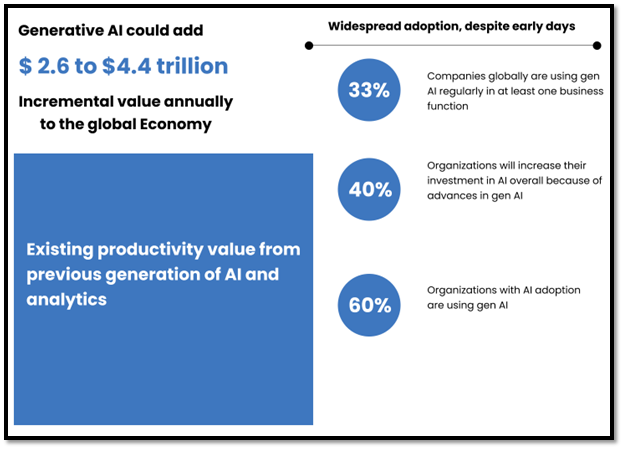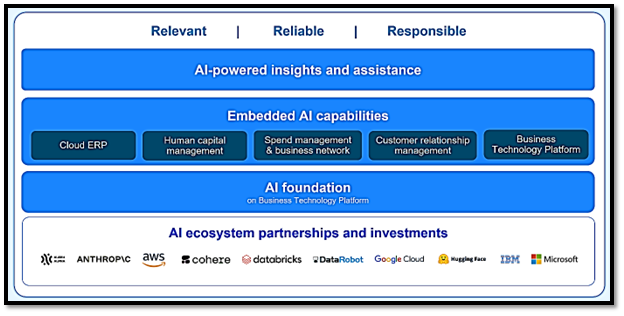The fervor surrounding Artificial Intelligence (AI) remains constant, particularly with the spotlight now on generative AI. Following initial presentations that sparked awe, many decision-makers reach a common conclusion: the necessity for an AI Strategy. In essence, AI, much like any other beloved technology, is a tool. Its proper utilization can yield immense value, yet misuse can result in significant capital loss.
Developing an AI strategy isn’t merely about following the latest technological trend; it’s about methodically identifying the areas within a business where AI can deliver tangible value. It involves crafting a detailed roadmap for integrating AI into business operations to enhance performance, efficiency, and overall results. This process is pivotal for steering a company’s trajectory in the digital age.

Figure 1 - GenAI Total Economic Impact
In a nutshell, an AI strategy outlines how a company plans to incorporate artificial intelligence (AI) into its operations. It covers aspects like the company’s vision for AI, the technologies to be used, and the resources required. This strategy aims to identify ways AI can improve products or services, streamline internal processes, or spur innovation.
Additionally, an AI strategy involves managing change within the organization. This includes preparing teams for AI-driven transformations, developing new skills, and addressing ethical and societal concerns related to AI. It ensures that AI initiatives align with the company’s values and social responsibilities.
Overall, the goal of an AI strategy is to provide a roadmap for leveraging AI effectively, anticipating challenges, and seizing opportunities for growth and innovation in an increasingly AI-driven business environment.
Focusing Your AI Strategy on Creating Value
Central to crafting an AI strategy is the fundamental query: How can this cutting-edge technology deliver value to my endeavors, my organization, or the broader community? This involves harnessing AI capabilities to optimize workflows, boost organizational effectiveness, and ultimately yield increased returns on investment.
Moreover, an AI strategy can extend its focus beyond purely financial gains to encompass broader societal benefits, including sustainability initiatives. Consequently, the pathway to developing a successful AI strategy must align closely with the overarching business objectives and social aspirations of your company.


Figure 2 - Bottom Line and Top Line Benefits of AI per Line of Business
Let's break down these objectives individually:
Optimizing Bottom Line Performance with AI
AI holds the potential to significantly enhance operational efficiencies, leading to substantial cost savings and improved financial AI holds the potential to significantly enhance operational efficiencies, leading to substantial cost savings and improved financial performance. By automating complex processes and identifying inefficiencies, AI can streamline operations in areas such as manufacturing, supply chain management, and maintenance. For instance, predictive models powered by AI can anticipate equipment failures, enabling proactive maintenance and preventing costly disruptions. performance. By automating complex processes and identifying inefficiencies, AI can streamline operations in areas such as manufacturing, supply chain management, and maintenance. For instance, predictive models powered by AI can anticipate equipment failures, enabling proactive maintenance and preventing costly disruptions.
Fueling Top Line Growth with AI
Beyond cost reduction, AI offers opportunities for revenue growth by enhancing sales and customer experiences. Through personalized recommendations, market trend analysis, and identification of new opportunities, AI can drive sales of existing products and services. Furthermore, AI’s capacity to analyze large datasets enables businesses to develop augmented products and innovative services that significantly increase customer value and revenue.
Meeting Regulatory and Compliance Needs with AI
In today’s complex regulatory landscape, AI can simplify compliance processes by automating manual tasks, monitoring regulatory changes, and ensuring adherence to standards. By reducing human error and providing real-time insights, AI helps businesses mitigate the risk of compliance failures and associated penalties.
Fulfilling Larger Political and Social Goals with AI
AI has the potential to address broader societal and environmental challenges by optimizing resource usage and promoting sustainability. Through analysis of energy consumption patterns and recommendations for improvements, AI can support companies in reducing waste and achieving carbon neutrality. By aligning operations with global climate goals, businesses can contribute to larger political and social objectives.
Human Capital: Key to Effective AI Strategy
The human element plays a pivotal role in the success of an AI strategy. Meaningful adoption of AI begins with strong support from top executives who champion AI initiatives, allocate resources, and foster collaboration across departments. The designated AI leader should possess a deep understanding of AI’s potential and limitations, translating this knowledge into a strategic vision aligned with business objectives. Successful outcomes may include cost-saving projects or revenue generation, as well as nurturing a culture of AI literacy within the organization. AI literacy among all employees is equally crucial. Staff at every level should grasp AI’s capabilities and limitations, enabling them to set realistic expectations, identify valuable AI applications, and address challenges effectively. Understanding the importance of data is fundamental, empowering employees to utilize AI tools efficiently by enhancing their data literacy skills—essential for reading, analyzing, and leveraging data effectively in AI-driven initiatives.
Furthermore, fostering a continuous learning culture is essential for seamless AI integration. This involves providing regular training on AI advancements, encouraging curiosity and critical thinking, fostering interdisciplinary collaborations, and acknowledging AI-driven innovations. Cultivating AI understanding and curiosity at all levels—from leadership to frontline staff—is essential for organizations to truly embrace and leverage AI effectively. In essence, the human aspect, including executive sponsorship and organization-wide AI literacy, is paramount for harnessing AI’s power effectively. Organizations should not merely use AI but embed it into their culture, fostering a deep understanding and enthusiasm for AI across all levels of the organization. This journey toward becoming an AI-driven organization necessitates a commitment to ongoing learning and collaboration.
Navigating Innovation and Change Management Through AI
In an era of perpetual innovation, organizations face a daunting yet exhilarating challenge. To effectively manage the ongoing identification, prioritization, and implementation of AI opportunities, a structured and systematic approach is essential. This entails establishing dedicated teams or roles tasked with scouting potential AI innovations and assessing them based on factors such as feasibility, strategic alignment, value creation potential, and associated risks. Clear workflows and approval processes must also be put in place to streamline selection and implementation efforts, ensuring efficiency and foresight. Similar to the DevOps concept in software development, AI innovations often unfold rapidly and iteratively. Thus, organizations must cultivate strategies for continuously embracing AI innovations. This approach facilitates ongoing improvement and evolution, replacing extensive overhauls with agile, adaptive practices. Embracing a readiness strategy involves fostering a culture of lifelong learning, updating skill sets, and understanding that AI integration requires rethinking and reshaping existing processes, systems, and business models.
Crucially, defining clear metrics is paramount in managing AI innovation and change. While traditional metrics tend to focus solely on the bottom line, AI success metrics should encompass a broader spectrum. Beyond immediate business value such as cost savings and revenue growth, these metrics should also capture intangible benefits like enhanced customer experience, strengthened brand perception, increased employee satisfaction, and improved decision-making capabilities. Furthermore, recognizing that AI adoption is an ongoing journey, organizations must gauge the maturity of their AI strategy over time. This includes assessing factors such as the organization’s AI literacy, the breadth of AI applications deployed, and the level of AI integration in decision-making processes.
The Technological Foundation for a Successful AI Strategy
Choosing the appropriate AI technology for a specific project is essential and demands a deep understanding of the business requirements, objectives, expected outcomes, and technological limitations. With a wide array of AI technologies available, ranging from machine learning algorithms for predictive analytics to Natural Language Processing for sentiment analysis, it’s critical to assess factors such as tool complexity, capabilities, and compatibility with existing tech infrastructure.
Additionally, Data Management and Data Preparation play a crucial role in AI projects. Often referred to as the ‘new oil,’ data serves as the cornerstone of AI initiatives. Approximately 80% of an AI project revolves around data management and preparation, encompassing tasks like data collection, cleansing, structuring, and storage. Various technologies contribute to these processes: databases and data warehouses ensure secure and organized data storage, data integration tools facilitate cleansing and consolidation of data from diverse sources, and data visualization tools aid in identifying patterns and extracting actionable insights. Choosing the right combination of technologies for data management is essential for unlocking the potential of AI and delivering high-quality outcomes.


Figure 3 - SAP Business AI Stack
While technology is crucial, the success of an AI project heavily relies on the capabilities of your team. The specific skills and resources needed vary depending on the nature of the project, ranging from data scientists and machine learning engineers for algorithm development to data analysts and software engineers for data management and infrastructure setup. However, the AI skills gap presents a challenge, necessitating a blend of internal training programs and external hiring to address it effectively.
Unlocking Value with AI: A Rapid Approach to Strategy Success
Navigating the realm of AI strategy may seem daunting at first glance. Indeed, it entails significant effort and time. However, the rapid pace of innovation means that strategizing for months might render your ideas obsolete before they’re even implemented. While an AI strategy is indispensable, it’s essential to complement it with quick wins and swift innovations that deliver immediate value or provide valuable insights through experimentation. Embracing a mindset of ‘Try fast, fail fast, succeed fast’ is pivotal in the iterative process of AI projects, where multiple iterations are often necessary to strike the right balance between AI potential and business impact. A pragmatic starting point for an AI strategy involves leveraging pre-built and packaged AI solutions that integrate seamlessly with enterprise software. These solutions offer a pathway to rapid value creation by swiftly identifying opportunities where AI can enhance productivity, reduce costs, or drive revenue growth. By embracing this approach, organizations can capitalize on early successes, maintain momentum, learn through practical experience, and make adjustments as necessary.
Harvesting Instant Outcomes with SAP Business AI Solutions
Explore the potential of SAP Business AI solutions to swiftly achieve significant results across various domains:
- Enhanced Receivables Management in Finance: SAP AI streamlines receivables management processes, minimizing manual efforts while ensuring precise forecasting, early identification of payment defaults, and optimized cash flows.
- Personalized Learning Recommendations in Human Capital Management: SAP’s AI tools revolutionize the learning experience by offering tailored recommendations to employees based on their roles, career aspirations, and performance requirements. This fosters higher engagement levels and cultivates a skilled and adaptable workforce.
- Predictive Sourcing in Purchasing: SAP’s AI solutions empower purchasing departments to predict sourcing items and supplies intelligently. This predictive capability optimizes procurement processes, strengthens supplier relationships, and mitigates supply chain disruptions.
- Dynamic Product Recommendations and Sales Order Automation in Sales: Leveraging SAP Business AI, businesses can expedite sales efforts with personalized product recommendations aligned with customer preferences and purchase history. Integrating AI into sales order automation enhances accuracy, speeds up transactions, and enhances customer satisfaction.


Figure 4 - SAP AI-powered scenarios per Line of Business
Conclusion
SAP’s Business AI solutions offer a rapid pathway to value creation, enabling organizations to harness the power of AI across various domains. By leveraging pre-built AI solutions, businesses can achieve immediate results in areas such as finance, human capital management, purchasing, and sales. Embracing a mindset of agility and experimentation, coupled with strategic AI adoption, allows organizations to stay ahead in the ever-evolving digital landscape and drive transformative change.
Additionally, partnering with VE3 can further amplify this transformative journey by providing tailored AI solutions and expert guidance, ensuring optimal integration and utilization of AI technologies for sustained growth and innovation. To know more, explore our innovative digital solutions or contact us directly.


















